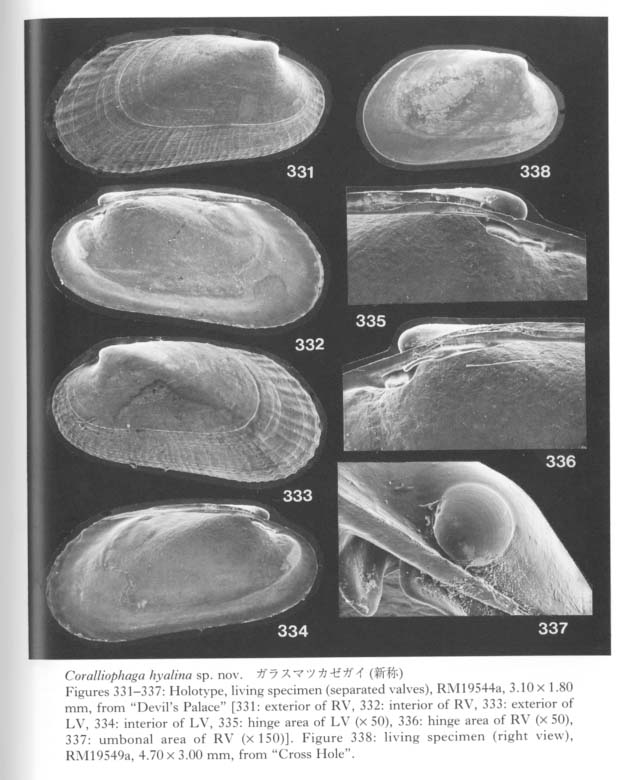Family Trapeziidae Lamy, 1920
Genus Coralliophaga de Blainville, 1824
Coralliophaga hyalina sp. nov.
Figures 331-338

1992. Vesicomyidae? sp., Kase and Hayami,Jour. Moll, Studies, vol.58, p.448, listed.
Type and Material.—Holotype, RM19544a, a living specimen, from the bottom sediments of "Devil's Palace" of Shimoji Islet, Miyako Islands. Paratypes: RM19544 (living) from the type locality, RM19545 (dead) from "Fool's Palace", RM19546 (dead) from "Witch's House", RM19611 (dead) from "Coral Hole" of Shimoji Islet. RM19547 (dead) from "Lunch Hole", RM19548 (dead) from "W-arch", RM19549 (living) from "Cross Hole" of Irabu Islet. RM19550 (dead) from "Shodokutsu" of Ie Islet.
Diagnosis.— Very small-sized, hyaline, cocoon-shaped species of Coralliophaga, characterized by expanded posterior area, a little concave ventral margin, nearly smooth surface but with numerous variably developed radial threads, and platy cardinal teeth disposed subparallel to valve margin.
Description.—Shell very small for genus, scarcely exceeding 5.5 mm in length, elongate-elliptical, 1.5-1.9 times longer than high, very thin and hyaline, moderately convex, not carinate, with reduced anterior part and expanded posterior part. Umbo small, very prosogyrous, located about one-fifth of shell-length from anterior end. Short antero-dorsal and long postero-dorsal margins gently arcuate with similar curvature, not clearly separated below umbo. Ventral margin slightly concave in middle portion. Lunule and escutcheon not discriminated. Early dissoconch nearly smooth except for weak commarginal lamellae, but later dissoconch marked with variably developed radial threads, which give weak marginal crenulations along posterior margin. Dentition surely of cyprinoid, though difficult to formulate, characterized by two platy cardinal teeth subparallel to dorsal margin in each valve and an elongated ridge- like lateral tooth along postero-dorsal margin in RV. Ligament external, elongated along post-umbonal margin. Pallial line shallowly sinuate below posterior adductor scar, Pd I small, hemispherical, ranging 72-97 µm in maximum diameter; Pd II reddish brown in fresh shell; veliconch (Pd I +Pd II) ranging 138-166 µm in maximum diameter.
Remarks.— The genus Coralliophaga is represented by a few coral-nestling species in tropical-subtropical shallow seas in both the Indo-West Pacific and the Atlantic. This genus is generally characterized by somewhat irregular outline and several raised commarginal lamellae in the adult stages. Although the living specimens of the present species were collected from the sediment surface, they remind us of immature individuals of Coralliophaga species in their cocoon-shaped outline, translucent shells, subparallel lamellar cardinal teeth and feeble radial threads, though the development of radial threads as well as the form ratio is considerably variable. The cocoon-shaped outline is also considerably similar to that of the type-species of the subgenus Oryctomya Dall, 1898, from the Eocene of Alabama, but the shell is much smaller and the radial threads are not tuberculated in the present species.
The variably developed radial threads and general outline are similar to those of the umbonal part of Coralliophaga Coralliophaga (Gmelin, 1791), which is known as a dominant coral nestler in the western Pacific (Morton, 1980, 1983, 1990). The limited maximum size in several samples and the fact that the commarginal lamellae often becoming denser toward the ventral margin indicate that the present material includes adult individuals. At present, we regard this species as a product of paedomorphic evolution.
Distribution.— Common in several sublittoral caves of Shimoji, Irabu and Ie Islets, Ryukyu Islands. This species also occurs in "Balicasag Cave" off Panglao Islet of Bohol Island, the Philippines, and "Chandelier cave" near Koror, Palau Islands.
Genus Glossocardia Stoliczka, 1870
Glossocardia was proposed by Stoliczka (1870: 189) on a large ventricose species, Cypricardia obesa Reeve, 1843, from India. It has been generally assigned to the family Trapeziidae, as Stoliczka (1870) and Keen (in Cox ef al., 1969) regarded it as a subgenus of Trapezium Megerle von Mühlfeld, 1811. Although it looks somewhat similar to Trapezium in the subquadrate and carinated shell, the hinge structure, especially the disposition of well-developed cardinal and posterior lateral teeth reminds us of some genera of the Cretaceous Arcticidae, e.g. Veniella Stoliczka, 1870. Little has been known about the ancestry and fossil record of Glossocardia, but its archaic morphology and cryptic habitat seem to suggest that this genus is an example of "living fossils".